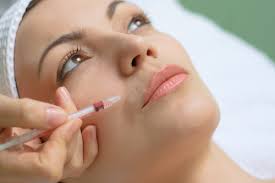What is Ultherapy?
Ultherapy is the only non-invasive treatment cleared by the FDA to lift skin on the neck, under the chin and above brow. Ultherapy treats the face and neck using focused ultrasound energy, and stimulates the body’s natural production of collagen and elastin to gradually lift and tighten skin without any downtime.
How is Ultherapy different from other cosmetic procedures?
Ultherapy is the only non-surgical cosmetic procedure that uses focused ultrasound to stimulate the growth of new collagen deep within the skin. Thanks to ultrasound’s unique ability to bypass the top layer of the skin, Ultherapy can specifically target the deep foundation below the skin – typically addressed in cosmetic surgery – without cutting or disrupting the surface of the skin.
Ultherapy is also the only procedure to use ultrasound imaging, which allows providers to actually see the layers of tissue targeted during treatment to ensure the energy is deposited to where it will be most optimal.
How long until I see results?
Patients may enjoy some initial effect but the ultimate lifting and toning will take place over 2-3 months, as tired collagen is replaced with new, more elastic collagen. As this collagen- building process continues, further improvements can appear up to 6 months following a procedure.
How long does it last?
Patients treated with Ultherapy still have fresh young collagen after a year’s time following the procedure, but skin continues to age. Future touch-up treatments can help keep pace with the aging process, which varies by individual.
Does it hurt?
Continual scientific and clinical research is conducted to enhance the treatment, and thanks to a recent development, the Ultherapy treatment is now more comfortable for patients! This new-and-improved treatment approach is proven to increase patient comfort of the procedure without impacting efficacy.
Of course, comfort thresholds vary from patient to patient, so some people may experience discomfort while the ultrasound energy is being delivered. This sensation is temporary and a positive signal that the collagen-building process has been initiated. Patients typically leave comfortable and excited about the benefits to come! Your practitioner will consult with you prior to your treatment to make your experience as pleasant as possible.
Are there any side effects?
There may be slight redness for up to an hour or so following the treatment, and a small percentage of patients may have slight swelling, tingling or tenderness to touch, but these are mild and temporary in nature.
Patients can expect to pay between $1000 and $5000, depending upon the areas being treated. Of course, the cost of Ultherapy can vary depending on geographic location and physician practice.
Is Ultherapy safe?
The procedure has been cleared by the FDA after demonstrating safety in clinical studies, and more than 250,000 treatments have been performed safely worldwide. In addition, ultrasound energy has a proven track record, with use in the field of medicine for more than 50 years.
How many treatments will I need?
The majority of patients only need one treatment; however, some may benefit from more than one treatment depending on how much laxity they have and their body’s own biological response to the ultrasound and the collagen-building process.
Who is a good candidate for Ultherapy?
A good candidate for Ultherapy is someone with skin that has some degree of laxity, to the point of looking, and often feeling, less firm. A lowered eyebrow line or sagging skin on the eyelids, for instance, is often the first sign of “maturing” skin. Loose skin on the neck and under the chin signals a patient might be a candidate. Typically, those in their thirties and older who have mild to moderate skin laxity are candidates.
While Ultherapy is not a replacement for a surgical face or neck lift, there are many people who want some lifting but are not ready for surgery, either mentally, physically or financially. There also are younger people who want to “stay ahead of the game” as well as those looking to prolong the effects of cosmetic surgery.
What about treating anatomical regions other than the face?
Currently, Ultherapy is a treatment for the face and neck with specific clinical indications for lifting the skin on the neck, under the chin and above the brow.
What does collagen do? How does Ultherapy stimulate the creation of collagen?
Collagen is a natural protein that gives skin its youthfulness by keeping it firmed and toned. As we age, collagen loses its strength and its ability to stand up to the effects of gravity that pull the skin downward. Ultherapy uses focused ultrasound to generate a thermal effect under the skin. The thermal effect essentially jumpstarts a repair process that strengthens existing collagen and produces fresh, new collagen.
Where can I get an Ultherapy treatment?
TO LEARN MORE ABOUT OUR ULTHERAPY SERVICES, PLEASE CONTACT US (817) 473-2120 OR EMAIL APPOINTMENTS@MARKBISHARAMD.COM TO SCHEDULE AN APPOINTMENT.
Spring, Texas Sugar Land, Texas Temple Texarkana, Texas Texas City, Texas The Colony, Texas The Woodlands Tyler, Texas University Park Victoria, Texas Waco, Texas Watauga, Texas Waxahachie Weatherford, Texas Weslaco, Texas Wichita Falls, Texas Wylie,





